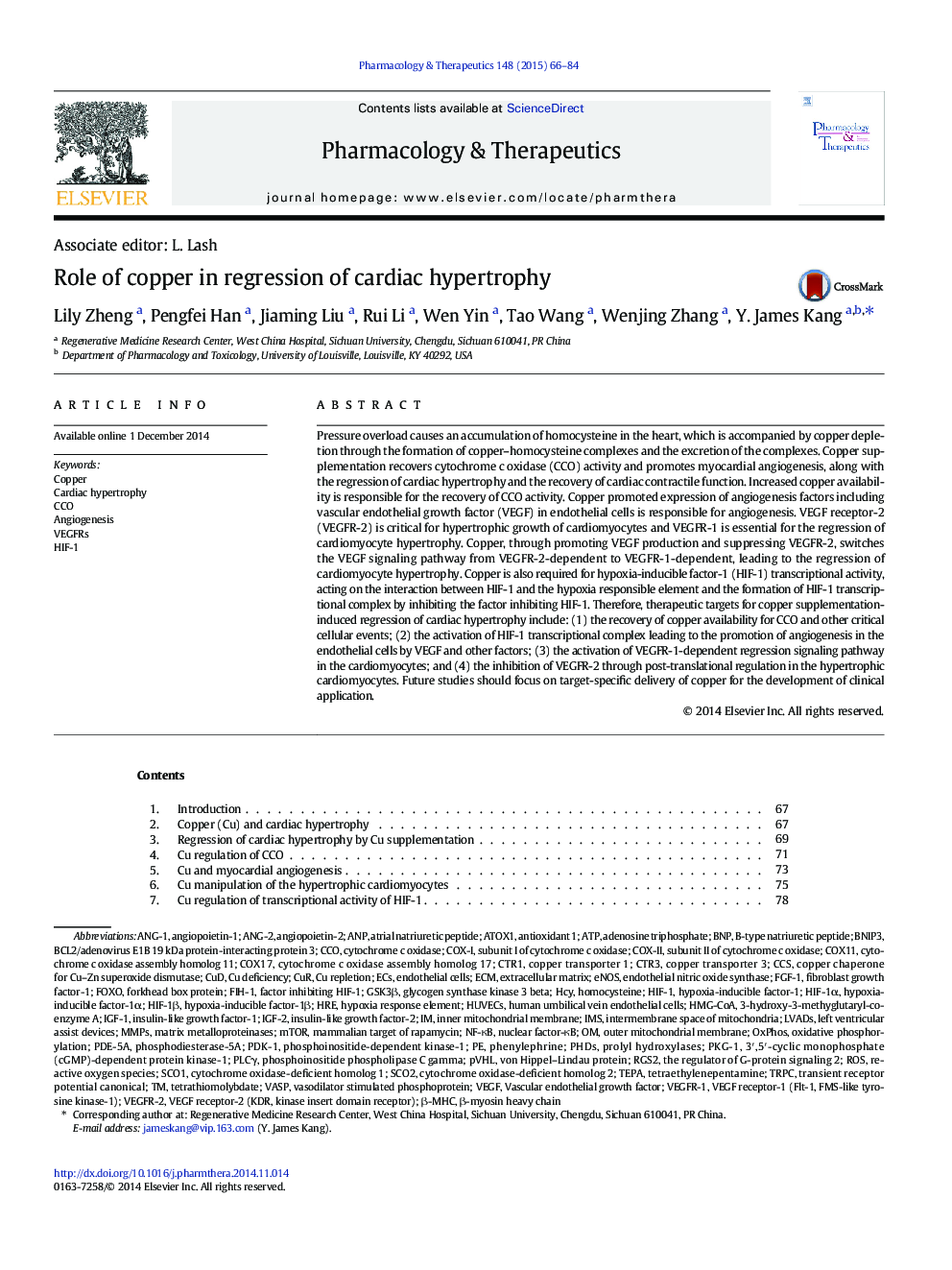| Article ID | Journal | Published Year | Pages | File Type |
|---|---|---|---|---|
| 5843974 | Pharmacology & Therapeutics | 2015 | 19 Pages |
Abstract
Pressure overload causes an accumulation of homocysteine in the heart, which is accompanied by copper depletion through the formation of copper-homocysteine complexes and the excretion of the complexes. Copper supplementation recovers cytochrome c oxidase (CCO) activity and promotes myocardial angiogenesis, along with the regression of cardiac hypertrophy and the recovery of cardiac contractile function. Increased copper availability is responsible for the recovery of CCO activity. Copper promoted expression of angiogenesis factors including vascular endothelial growth factor (VEGF) in endothelial cells is responsible for angiogenesis. VEGF receptor-2 (VEGFR-2) is critical for hypertrophic growth of cardiomyocytes and VEGFR-1 is essential for the regression of cardiomyocyte hypertrophy. Copper, through promoting VEGF production and suppressing VEGFR-2, switches the VEGF signaling pathway from VEGFR-2-dependent to VEGFR-1-dependent, leading to the regression of cardiomyocyte hypertrophy. Copper is also required for hypoxia-inducible factor-1 (HIF-1) transcriptional activity, acting on the interaction between HIF-1 and the hypoxia responsible element and the formation of HIF-1 transcriptional complex by inhibiting the factor inhibiting HIF-1. Therefore, therapeutic targets for copper supplementation-induced regression of cardiac hypertrophy include: (1) the recovery of copper availability for CCO and other critical cellular events; (2) the activation of HIF-1 transcriptional complex leading to the promotion of angiogenesis in the endothelial cells by VEGF and other factors; (3) the activation of VEGFR-1-dependent regression signaling pathway in the cardiomyocytes; and (4) the inhibition of VEGFR-2 through post-translational regulation in the hypertrophic cardiomyocytes. Future studies should focus on target-specific delivery of copper for the development of clinical application.
Keywords
GSK3βCCOeNOSIGF-1PDK-1TRPCHIF-1αβ-MHCBNPHIF-1βTetrathiomolybdateRGS2LVADsangiopoietin-2ECMVASPBNIP3BCL2/adenovirus E1B 19 kDa protein-interacting protein 3PLCγHcyHMG-CoASCO2IGF-2VEGFR-2VEGFR-1HREpVHLCUDangiopoietin-1SCO1NF-κBCCSfactor inhibiting HIF-1MmpsCURCox17COX-IIIMSANPFGF-1HIF-1VEGFRsHUVECSOXPHOSAtox1TEPACTR1mTORcox-IECsROSTetraethylenepentamineAng-1Ang-2Adenosine TriphosphateATPAngiogenesisvon Hippel–Lindau proteininsulin-like growth factor-1FIH-1Copper transporter 1inner mitochondrial membraneLeft ventricular assist devicesPhDsβ-myosin heavy chainHuman umbilical vein endothelial cellsEndothelial cellsendothelial nitric oxide synthasecytochrome c oxidasehypoxia-inducible factor-1αhypoxia response elementouter mitochondrial membranehypoxia-inducible factor-1Vascular endothelial growth factorVascular Endothelial Growth Factor (VEGF)Insulin-like growth factor-2nuclear factor-κBFoxOOxidative phosphorylationphenylephrineFibroblast growth factor-1Extracellular matrixMatrix metalloproteinasesCoppermammalian target of rapamycinhomocysteineCardiac hypertrophyPhosphoinositide-dependent kinase-1Vasodilator stimulated phosphoproteintransient receptor potential canonicalforkhead box proteinprolyl hydroxylasesatrial natriuretic peptideB-type natriuretic peptideglycogen synthase kinase 3 betaReactive oxygen species
Related Topics
Health Sciences
Pharmacology, Toxicology and Pharmaceutical Science
Pharmacology
Authors
Lily Zheng, Pengfei Han, Jiaming Liu, Rui Li, Wen Yin, Tao Wang, Wenjing Zhang, Y. James Kang,
